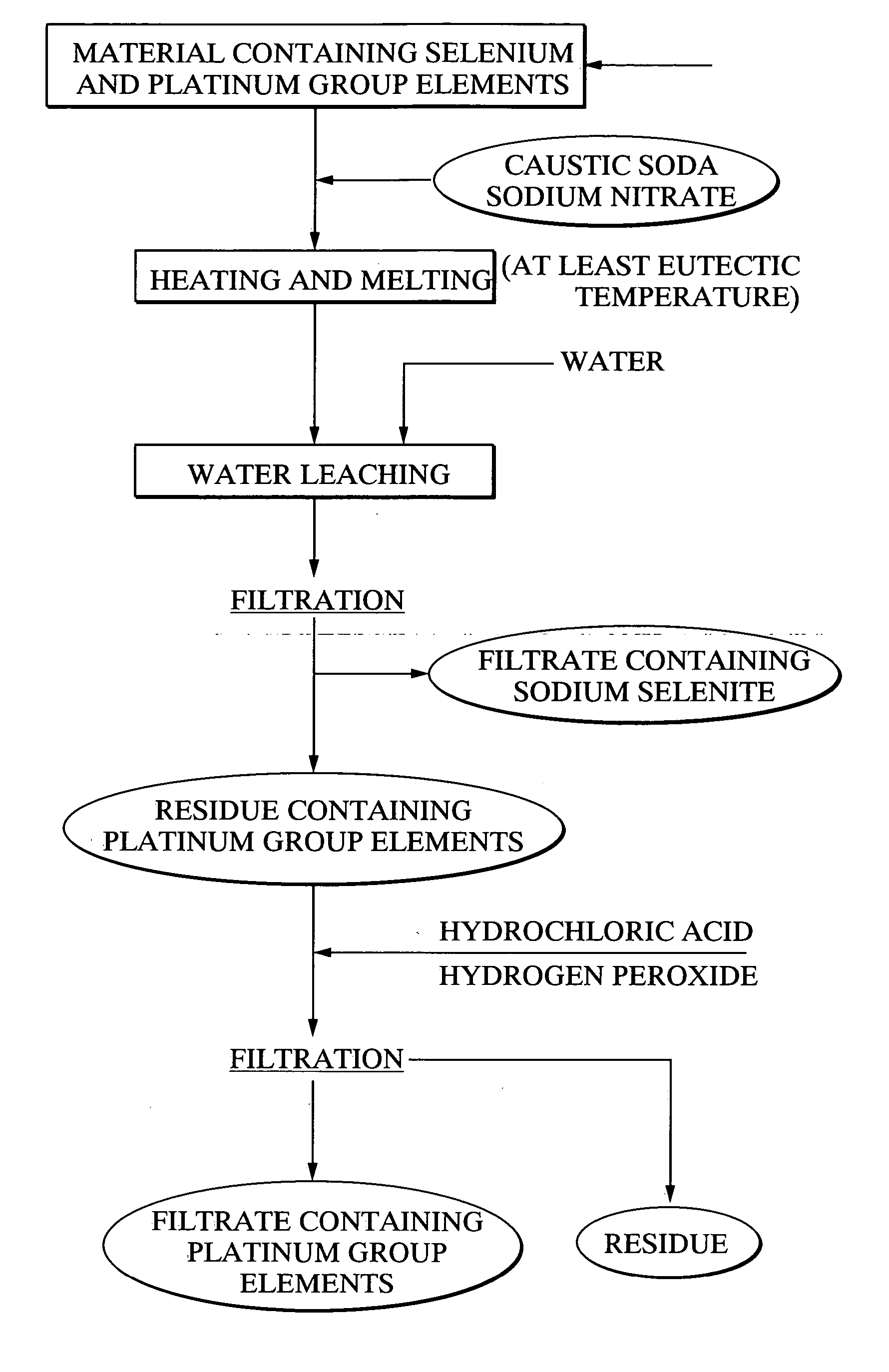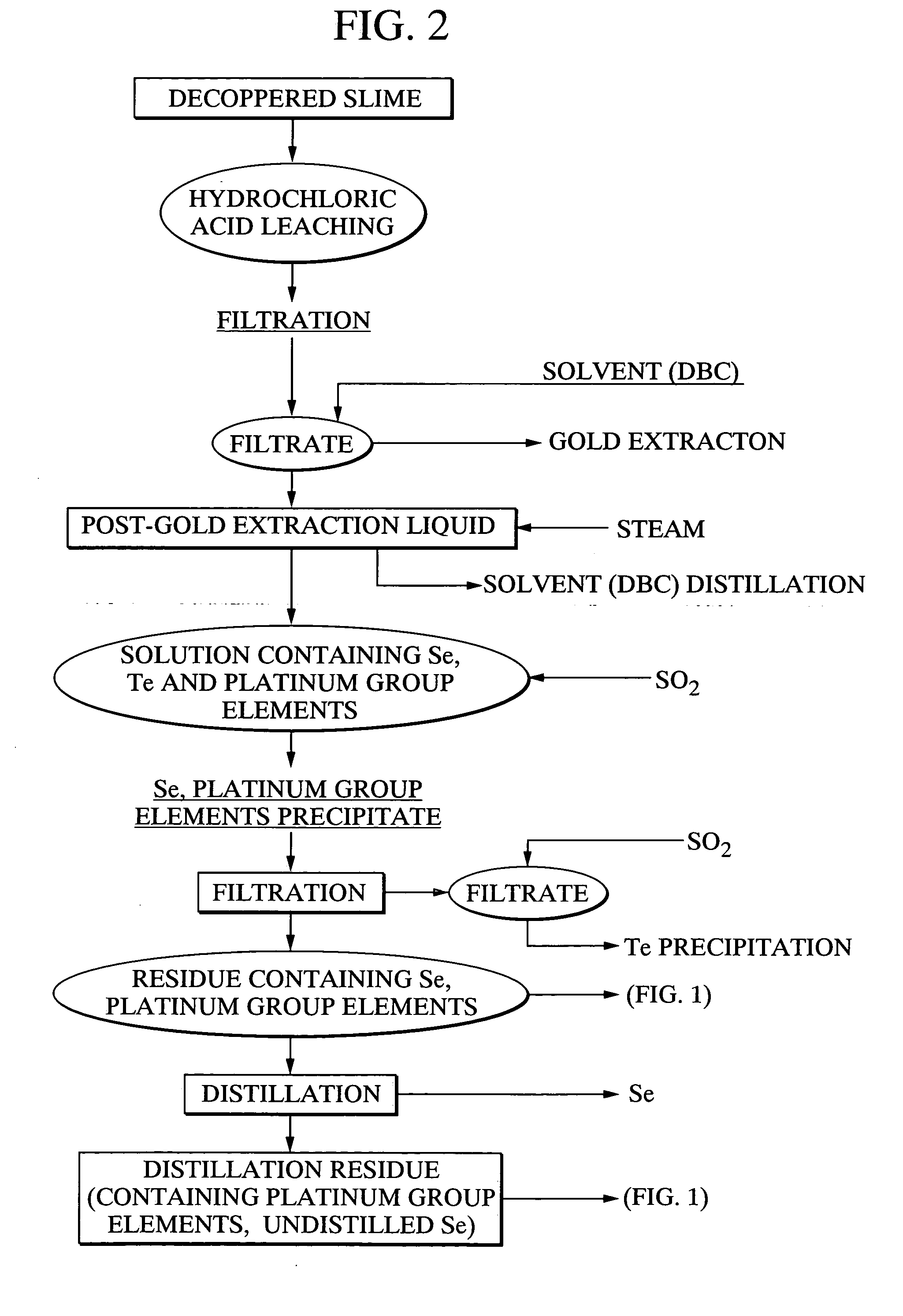Method for separating platinum group element
a platinum group element and platinum group technology, applied in the field of platinum group element separation, can solve the problems of difficult dissolution, inability to separate and recover, and ineffective inability to function as an oxidizing agen
- Summary
- Abstract
- Description
- Claims
- Application Information
AI Technical Summary
Benefits of technology
Problems solved by technology
Method used
Image
Examples
example 1
[0118] Using 20 g of a platinum group element-containing material, comprising palladium selenide as the primary component, as a raw material, 21.7 g of caustic soda and 11.5 g of sodium nitrate were mixed with the raw material, and the mixture was heated for 2 hours at 400° C., forming a melt. Following cooling of the melt, 500 ml of water was added, and the mixture was stirred for one hour and then filtered. 97.4% of the selenium from the above raw material had been leached into the filtrate. Furthermore, platinum and palladium were not detected in the filtrate. The quantity of hexavalent selenium in the filtrate was less than 10%. Meanwhile, the filtered residue was repulped with 3N hydrochloric acid, and was then oxidized with hydrogen peroxide. As a result, 95% of the palladium and 99% or greater of the platinum were leached into the solution.
example 2
[0119] With the exception of using 20.3 g of caustic soda and 14.4 g of sodium nitrate, the same method as the example 1 was used to heat and melt 20 g of the platinum group element-containing material comprising palladium selenide as the primary component, and then subject this melt to water leaching and filtering. The leaching rate of selenium into the filtrate was 98.2%. Platinum and palladium were not detected in the filtrate. Furthermore, the proportion of hexavalent selenium in the filtrate was less than 10%. Meanwhile, when the filtered residue was repulped with 3N hydrochloric acid, and then oxidized with hydrogen peroxide, the leaching rate of palladium into the solution was 95%, and the leaching rate for platinum was 99% or greater.
example 3
[0120] With the exception of using 23.0 g of caustic soda and 8.6 g of sodium nitrate, the same method as the example 1 was used to heat and melt 20 g of the platinum group element-containing material comprising palladium selenide as the primary component, and then subject this melt to water leaching and filtering. The leaching rate of selenium into the filtrate was 97.2%. Platinum and palladium were not detected in the filtrate. Furthermore, the proportion of hexavalent selenium in the filtrate was less than 10%. Meanwhile, when the filtered precipitate was repulped with 3N hydrochloric acid, and then oxidized with hydrogen peroxide, the leaching rate of palladium into the solution was 95%, and the leaching rate for platinum was 99% or greater.
PUM
| Property | Measurement | Unit |
|---|---|---|
| Temperature | aaaaa | aaaaa |
| Dissociation constant | aaaaa | aaaaa |
| Temperature | aaaaa | aaaaa |
Abstract
Description
Claims
Application Information
 Login to View More
Login to View More - R&D
- Intellectual Property
- Life Sciences
- Materials
- Tech Scout
- Unparalleled Data Quality
- Higher Quality Content
- 60% Fewer Hallucinations
Browse by: Latest US Patents, China's latest patents, Technical Efficacy Thesaurus, Application Domain, Technology Topic, Popular Technical Reports.
© 2025 PatSnap. All rights reserved.Legal|Privacy policy|Modern Slavery Act Transparency Statement|Sitemap|About US| Contact US: help@patsnap.com



